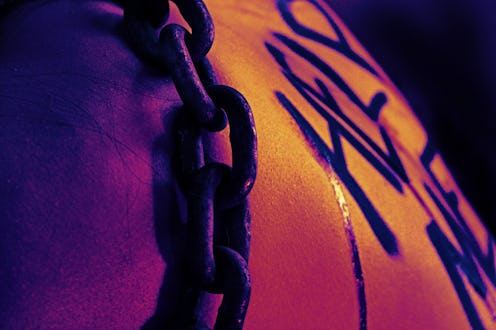News
What You Didn't Know About Human Trafficking

On Thursday, hundreds of people gathered in Compton, California to march in protest of human trafficking. It's an issue that has been gathering growing attention — according to a study released Thursday by the Polaris Project, reports of human trafficking have tripled over the last five years. But that's not due to an increase in trafficking; the report suggests that, on the contrary, growing awareness and advances in technology have just led to more people calling in and reporting it. The report also had another surprising finding: U.S. citizens are the victims of nearly half of all sex trafficking cases, also accounting for 20% of labor trafficking cases.
According to the report, the last five years has seen over 9,298 unique cases of human trafficking reported to the National Human Trafficking Resource Center (NHTRC), a national hotline call center in the U.S. From 2008 to 2012 alone, there was a 259 percent increase in calls to the NHTRC, and over 72,000 interactions, and that's largely thanks to a large-scale effort to raise public understanding of human trafficking.
“There has been a coordinated effort from the media, government, entertainment industry, non-profit sector and state-based initiatives to put this hotline number out all over the country so that the power of individual community experiences can be channeled into one place which can function as a central hub to build this centralized data collection and information clearing-house. Our report is a reflection of that recipe,” Bradley Myles, CEO of the Polaris Project, said. He added:
“In so many different times of slavery in the past people weren’t able to pick up the phone and say 'help me,' but now with cell phones, GPS, smart phones, 4G wireless we can really leverage modern technology and put it to good use by creating lifelines for victims. Fast-forward to the present day and we have seen a major increase in calls from survivors which as of October 31, 2013, stands at 4,833 survivor calls."
As might be expected, women were the victims of 85 percent of all sex trafficking cases, but, perhaps more surprisingly, men accounted for 40 percent of labor trafficking cases (which commonly involved domestic work, peddling rings and restaurants). Also perhaps contrary to what might be expected, many of those exploited have at least a mid-level education.
The study reported 5,932 cases of sex trafficking in total, where over 40 percent of the victims were under 18 years old. Over 40 percent were in a pimp-controlled situation — most of the victims were recruited through a friend, or by pimps pretending to be their boyfriend or girlfriend (roughly 42% of recruiters are female). Around 17 percent of pimps posed as a type of benefactor, offering necessities like food, with the most common places for recruitment being homeless shelters, rehab facilities and foster homes. Forced abductions were suprisingly rare, accounting for only a tiny percentage of trafficking cases.
In Compton, a city in Los Angeles country, hundreds protestors marched on Thursday to demand stronger penalties for sex-traffic customers and pimps — in 2006, only one person was convicted for every 800 people trafficked. “According to our laws, you get less jail time for selling women than for selling drugs,” said Compton Mayor Aja Brown. It's estimated that roughly 3,000 children are trafficked in Los Angeles.
“These young girls are victims, and so our strategy is not to put them in a prosecutorial place, but to save them from those who should be prosecuted,” said Los Angeles County Sheriff Lee Baca.
Said Myles:
“People are reaching out to the national human trafficking hotline every single day and telling us that modern slavery is happening in their communities.Girls are forced by pimps to sell sex at truck stops. Domestic workers are abused by their employers. Men are isolated on farms with limited access to food and water. This report demonstrates that traffickers are not operating in just one city or region. We have identified potential cases of human trafficking in every state in the nation, and we are finding important trends that can help us stop this violence and exploitation.”
According to the report, the highest human trafficking levels were found in California. The state was closely followed by Texas, then Florida, New York and, finally, Illinois. Across the world, the International Labor Organization estimates that there are roughly 20.9 million victims of human trafficking — 56 percent of them are in Asia and the Pacific.
Image: Andrea Waldrop via Flickr